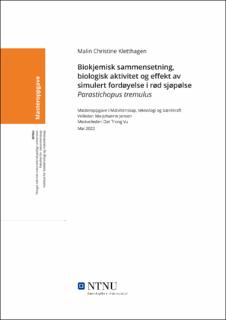| dc.contributor.advisor | Jensen, Ida-Johanne | |
| dc.contributor.advisor | Vu, Dat Trong | |
| dc.contributor.author | Kletthagen, Malin Christine | |
| dc.date.accessioned | 2022-06-30T17:20:04Z | |
| dc.date.available | 2022-06-30T17:20:04Z | |
| dc.date.issued | 2022 | |
| dc.identifier | no.ntnu:inspera:110155679:57788506 | |
| dc.identifier.uri | https://hdl.handle.net/11250/3001876 | |
| dc.description.abstract | Verdens befolkning er forventet å vokse kraftig. Det er allerede en stor global utfordring å produsere nok næringsrik og helsefremmende mat til den voksende befolkningen på en bærekraftig måte. Interessen for marine proteiner og bioaktive peptider har økt de senere årene, og bedre utnyttelse av havets ressurser er en stor mulighet. Det finnes mange lite utnyttede marine arter lavere i næringskjeden. Sjøpølse er en lite utnyttet marin ressurs med et stort potensiale for kommersiell høsting i Norge, og er antatt å være en kilde til bioaktive peptider. For å kunne bruke nye arter til humant konsum er det nødvendig å undersøke næringsinnholdet og andre helsefremmende komponenter. Målene med denne oppgaven var derfor å undersøke biokjemisk sammensetning og biologisk aktivitet; antioksidativ kapasitet og antihypertensiv kapasitet i arten rød sjøpølse Parastichopus tremulus, og studere hvordan bioaktiviteten endres gjennom fordøyelsen.
I denne oppgaven ble alle analysene utført på både rå og frysetørket P.tremulus. Resultatene indikerte at P.tremulus har et balansert næringsinnhold som er fordelaktig for menneskelig konsum. Fettinnholdet ble målt til å ligge på ca. 1 % og proteininnholdet på ca. 4 %. Proteinene var av god kvalitet, og inneholdt alle de essensielle aminosyrene som kunne detekteres. Det ble vist at frysetørkingen ikke påvirket næringsinnholdet i særlig grad. Protein-, vann- og askeinnholdet var likt, men det ble funnet signifikante forskjeller i fettinnholdet mellom rå og frysetørket rød sjøpølse. Til tross for statistisk signifikant forskjell var denne liten. Cirka 70 % av aminosyreinnholdet ble bevart gjennom frysetørkingen. Frysetørkingen påvirket derimot den antioksidative kapasiteten, og alle de tre benyttede metodene viste en noe større antioksidativ kapasitet i rå enn i frysetørket sjøpølse ved omregning til våtvekt. Store variasjoner og høye standardavvik gjorde det likevel vanskelig å konkludere med eksakt hvor store forskjellene var.
Det ble etablert en simulert fordøyelsesmodell, hvor utviklingen av antioksidativ- og antihypertensiv kapasitet gjennom fordøyelsen ble undersøkt. Resultatene viste en økende antioksidativ kapasitet og en økende frigjøring av aminosyrer utover i fordøyelsen. For den antihypertensive kapasiteten var det vanskelig å konkludere, ettersom resultatene hadde svært store variasjoner og standardavvik både mellom hver prøve og mellom replikatene. Resultatene viste også motsatt effekt fra tidligere studier ved at den ACE-hemmende effekten økte utover i fordøyelsen. | |
| dc.description.abstract | The world’s population is expected to grow rapidly. To produce enough nutritious and health promoting food to the growing population in a sustainable way is already a large, global challenge. The interest for marine proteins and bioactive peptides has increased the recent years, and better utilization of the ocean’s resources is a great opportunity. There are many little utilized marine species deeper in the food chain. Sea cucumber is a little utilized marine resource with a large potential for commercial harvesting in Norway and expected to be a source of bioactive peptides. To be able to use new species to human consumption, it is necessary to investigate the nutrient content and other health promoting components. The aims with this study were to investigate biochemical composition and biological activity; antioxidative and antihypertensive capacity in the species red sea cucumber, Parastichopus tremulus, and study how the bioactivity changes through digestion.
In this study, all analyzes were performed on both raw and freeze-dried P.tremulus. The results indicated that P.tremulus has a balanced nutrient content that is beneficial for human consumption. The fat content was measured to be approximately 1 % and the protein content 4 %. The proteins had good quality and contained all the essential amino acids that could be detected. It was shown that the freeze drying did not affect the nutrient content remarkable. The protein-, ash- and water content were similar for raw and freeze-dried sea cucumber, but a significant difference was found in the fat content. Despite the statistical significance, the differences were small. About 70 % of the amino acid content was preserved through freeze-drying. Freeze-drying on the other hand, affected the antioxidative capacity, and the results from all three methods showed a greater antioxidative capacity in raw compared to freeze-dried sea cucumber in wet weight. Large variations and high standard deviations made it difficult to conclude exactly how large the differences were.
A simulated digestion model was established, and the development of antioxidative and hypertensive capacity through digestion was investigated. The results showed an increasing antioxidative capacity and an increasing release of amino acids throughout the digestion. For the antihypertensive capacity, it was difficult to conclude. The results had large variations and standard deviations both between each sample and between the replicates and showed the opposite effect from previous studies with an increasing ACE-inhibiting effect thoroughout the digestion. | |
| dc.language | nob | |
| dc.publisher | NTNU | |
| dc.title | Biokjemisk sammensetning, biologisk aktivitet og effekt av simulert fordøyelse i rød sjøpølse Parastichopus tremulus | |
| dc.type | Master thesis | |
